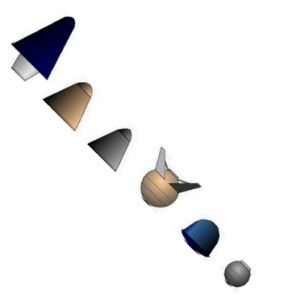
Home - Search - Browse - Alphabetic Index: 0- 1- 2- 3- 4- 5- 6- 7- 8- 9
A- B- C- D- E- F- G- H- I- J- K- L- M- N- O- P- Q- R- S- T- U- V- W- X- Y- Z
Aeronutronics Project 7969
 Project 7969 Designs Project 7969 ballistic designs. From left: Lockheed; Martin; Aeronutronics; Goodyear; McDonnell; Convair Credit: © Mark Wade |
Status: Study 1958. Gross mass: 1,150 kg (2,530 lb). Height: 2.13 m (6.98 ft).
The man within was enclosed in a gimbaled sphere and rotated to line the pilot up with accelerations. The vehicle would be launched by any one of several two-stage vehicles, including the USAF baseline Atlas Hustler. Deorbit would be accomplished by a retrorocket. The spacecraft was automatic and no pilot control functions were needed. The heat shield used graphite shingles. In case of booster failure during ascent to orbit the capsule would be ejected. The spacecraft had a ballistic coefficient (W/CdA) of 300 kg per square meter. Landing precision was within a 160 x 80 km footprint. It was expected that a first manned orbital flight could be only be achieved six years after go-ahead.
Family: Manned spacecraft. Country: USA. Launch Vehicles: Atlas, Atlas Agena A. Agency: USAF, Aeronutronics. Bibliography: 26, 483, 59.
Back to top of page
Home - Search - Browse - Alphabetic Index: 0- 1- 2- 3- 4- 5- 6- 7- 8- 9
A- B- C- D- E- F- G- H- I- J- K- L- M- N- O- P- Q- R- S- T- U- V- W- X- Y- Z
© 1997-2019 Mark Wade - Contact
© / Conditions for Use